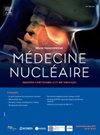Clinical protocols to monitor efficacy of [177Lu]Lu-PSMA radiopharmaceutical therapy in metastatic castration-resistant prostate cancer
IF 0.2
4区 医学
Q4 PATHOLOGY
Medecine Nucleaire-Imagerie Fonctionnelle et Metabolique
Pub Date : 2025-03-01
DOI:10.1016/j.mednuc.2025.01.172
引用次数: 0
Abstract
Introduction
To assess the prognostic value of post-therapy [177Lu]Lu-PSMA (LuPSMA)-SPECT/CT by visual RECIP 1.0 during LuPSMA radioligand therapy and to develop an evidence-based clinical protocol to monitor efficacy to LuPSMA.
Methods
Patients who received LuPSMA between April 2019 and November 2023 and who underwent at least two LuPSMA-SPECT/CT (SPECT) were included. Three independent readers interpreted pairs of baseline and interim LuPSMA-SPECT/CT after 2 cycles of therapy for visual Response Evaluation Criteria In PSMA-imaging (RECIP) 1.0. The primary outcome was the prognostic value of post-therapeutic SPECT by RECIP 1.0 for overall survival after LuPSMA. The secondary outcome was the agreement between SPECT and PSMA-PET/CT (PET) performed after 2 cycles of LuPSMA.
Results
In total, 105 patients were included. In SPECT PD was associated with shorter OS compared to SD (HR = 2.51 ; 95 % ; CI : 1.19–5.28 ; p = 0.015) and to PR (HR = 6.48 ; 95 % ; CI : 2.67–15.70 ; p < 0.001). 73/105(69.5 %) had a PET after 2 cycles. 7/73(10 %), 30/73(41 %), 22/73(30 %), and 30/73(41 %) patients had a tumor progression by SPECT, PET, SPECT + PSA, and PET + PSA, respectively. All 7/73(10 %) patients with PD by SPECT had PD by PET. The C-index for SPECT was inferior to the one of SPECT + PSA(0.54 vs. 0.62 ; p = 0.03) and PET(0.54 vs. 0.66 ; p < 0.001) while SPECT + PSA did not differ significantly from PET(0.62 vs. 0.66 ; p = 0.07).
Conclusion
Post-therapeutic SPECT/CT by RECIP 1.0 after 2 cycles of LuPSMA therapy is prognostic for overall survival and can be used for treatment response evaluation purposes. PSMA-PET/CT identified significantly higher number of patients with progressive disease compared to LuPSMA-SPECT/CT. A composite classification system of LuPSMA-SPECT/CT + PSA was not significantly different from interim PSMA-PET/CT for response evaluation to LuPSMA.
监测[177Lu]Lu-PSMA放射药物治疗转移性去势抵抗性前列腺癌疗效的临床方案
目的:通过视觉RECIP 1.0评估治疗后[177Lu] LuPSMA放射配体治疗期间Lu-PSMA (LuPSMA)-SPECT/CT的预后价值,并制定基于证据的临床方案来监测对LuPSMA的疗效。方法纳入2019年4月至2023年11月期间接受LuPSMA治疗并至少接受两次LuPSMA-SPECT/CT (SPECT)检查的患者。三位独立的读者在2个疗程的治疗后对基线和中期LuPSMA-SPECT/CT进行了解释,以评估psma成像(RECIP) 1.0中的视觉反应评价标准。主要终点是经RECIP 1.0检测的治疗后SPECT对LuPSMA患者总生存期的预后价值。次要结果是在2个周期的LuPSMA后进行SPECT和PSMA-PET/CT (PET)之间的一致性。结果共纳入105例患者。在SPECT中,PD与SD相比与更短的OS相关(HR = 2.51;95%;Ci: 1.19-5.28;p = 0.015)和PR (HR = 6.48;95%;Ci: 2.67-15.70;p & lt;0.001)。73/105(69.5%)患者在2个周期后复查PET。SPECT、PET、SPECT + PSA和PET + PSA分别显示7/73(10%)、30/73(41%)、22/73(30%)和30/73(41%)患者肿瘤进展。所有7/73(10%)SPECT诊断的PD患者都有PET诊断的PD。SPECT的c指数低于SPECT + PSA的c指数(0.54 vs 0.62;p = 0.03)和PET(0.54 vs. 0.66;p & lt;0.001),而SPECT + PSA与PET无显著差异(0.62 vs. 0.66;p = 0.07)。结论经2个疗程的LuPSMA治疗后,recp 1.0 SPECT/CT可预测患者的总生存期,可用于治疗反应评价。与LuPSMA-SPECT/CT相比,PSMA-PET/CT识别出的进展性疾病患者数量显著增加。LuPSMA- spect /CT + PSA复合分类系统与临时PSMA-PET/CT评价LuPSMA疗效无显著差异。
本文章由计算机程序翻译,如有差异,请以英文原文为准。
求助全文
约1分钟内获得全文
求助全文
来源期刊
CiteScore
0.30
自引率
0.00%
发文量
160
审稿时长
19.8 weeks
期刊介绍:
Le but de Médecine nucléaire - Imagerie fonctionnelle et métabolique est de fournir une plate-forme d''échange d''informations cliniques et scientifiques pour la communauté francophone de médecine nucléaire, et de constituer une expérience pédagogique de la rédaction médicale en conformité avec les normes internationales.

 求助内容:
求助内容: 应助结果提醒方式:
应助结果提醒方式:


